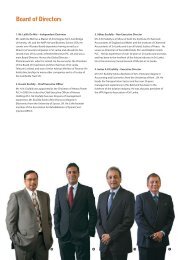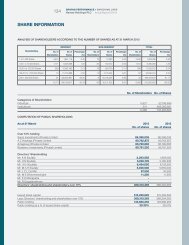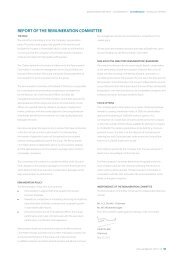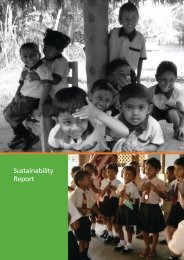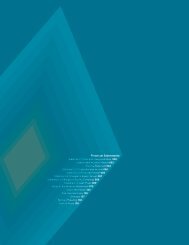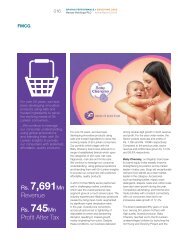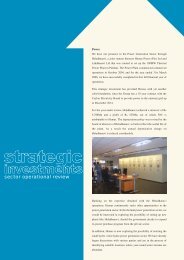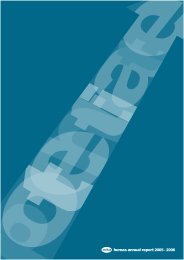Financial Statements - Hemas Holdings, Ltd
Financial Statements - Hemas Holdings, Ltd
Financial Statements - Hemas Holdings, Ltd
- No tags were found...
You also want an ePaper? Increase the reach of your titles
YUMPU automatically turns print PDFs into web optimized ePapers that Google loves.
<strong>Hemas</strong> <strong>Holdings</strong> PLC - Annual Report 2007 - 2008Notes to the <strong>Financial</strong> <strong>Statements</strong>The carrying amount of deferred income tax assets isreviewed at each Balance Sheet date and reduced to theextent that it is no longer probable that sufficient taxableprofit will be available to allow all or part of the deferredincome tax asset to be utilised.Deferred income tax assets and liabilities are measured at thetax rates that are expected to apply to the year when theasset is realised or the liability is settled, based on tax rates(and tax laws) that have been enacted or substantivelyenacted at the Balance Sheet date.Deferred income tax relating to items recognised directly inequity is recognised in equity and not in the IncomeStatement.c) Tax on dividend income from subsidiaries and associates isrecognized as an expense in the Consolidated IncomeStatement.2.3.3 Borrowing CostsBorrowing costs are recognised as an expense in the periodin which they are incurred, except to the extent whereborrowing costs that are directly attributable to theacquisition, construction, or production of an asset that takesa substantial period of time to get ready for its intended useor sale, are capitalized as part of that asset.2.3.4 Intangible Assets (Other than Goodwill)Intangible assets acquired separately are measured on initialrecognition at cost. The cost of intangible assets acquired in abusiness combination is fair value as at the date ofacquisition. Following the initial recognition of theintangible assets, the cost model is applied requiring theassets to be carried at cost less any accumulated amortisationand accumulated impairment losses. Internally generatedintangible assets, excluding capitalised development costs arenot capitalised and expenditure is reflected in the IncomeStatement in the year in which the expenditure is incurred.The useful lives of intangible assets are assessed to be eitherfinite or indefinite.Intangible assets with finite lives are amortised over theuseful economic life and assessed for impairment wheneverthere is an indication that the intangible asset may beimpaired. The amortisation period and the amortisationmethod for an intangible asset with a finite useful life isreviewed at least at each financial year end. Changes in theexpected useful life or the expected pattern of consumptionof future economic benefits embodied in the asset isaccounted for by changing the amortisation period ormethod, as appropriate, and treated as changes in accountingestimates. The amortisation expense on intangible assetswith finite lives is recognised in the Income Statement in theexpense category consistent with the function/nature of theintangible asset. Amortisation was commenced when theassets were available for use.Intangible assets with indefinite useful lives are tested forimpairment annually either individually or at the cashgenerating unit level. Such intangibles are not amortised.The useful life of an intangible asset with an indefinite life isreviewed annually to determine whether indefinite lifeassessment continues to be supportable. If not, the change inthe useful life assessment from indefinite to finite is made ona prospective basis.Intangible assets that are not yet available for sale are testedfor impairments at each financial year end, even if there isno indication that the asset is impaired.Gains or losses arising from derecognition of an intangibleasset are measured as the difference between the netdisposal proceeds and the carrying amount of the asset andare recognised in the Income Statement when the asset isderecognized.Research and Development CostsResearch costs are expensed as incurred. Intangible assetsarising from development expenditure on an individualproject is recognised only when the company candemonstrate the technical feasibility of completing theintangible assets so that it will be available for use or sale, itsintention to complete and its ability to use or sell the assets,how the assets will generate future economic benefits, theavailability of resources to complete the assets and the abilityto measure reliably the expenditure during the development.During the period of development, the assets are tested forimpairment annually. Following the initial recognition of thedevelopment expenditure, the cost model is appliedrequiring the assets to be carried at cost less anyaccumulated amortisation and accumulated impairmentlosses. Amortisation of the assets begins when developmentis completed and the asset is available for use. It is amortisedover the period of expected future sales. During the periodof which the asset is not yet in use it is tested for impairmentannually.2.3.5 InventoriesInventories are valued at the lower of cost and net realisablevalue, after making due allowances for obsolete and slowmoving items. Net realisable value is the price at whichinventories can be sold in the ordinary course of businessless the estimated cost of completion and the estimated costnecessary to make the sale.The cost incurred in bringing inventories to its presentlocation and conditions are accounted using the followingcost formulae:-62



